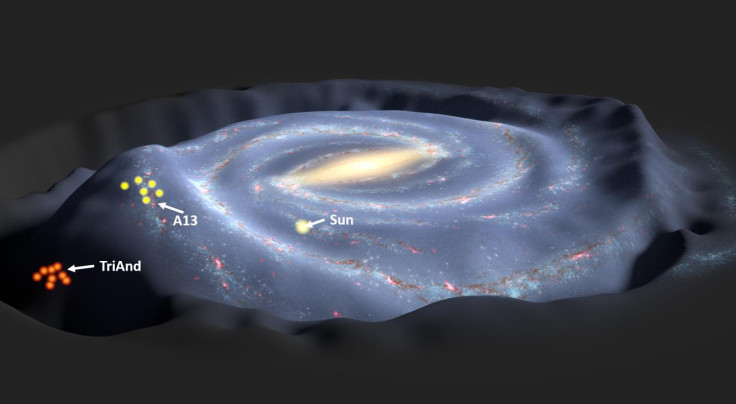Are the stars surrounding the Milky Way alien space invaders or were they booted out of the galaxy?
The halo of the Milky Way galaxy is the birthplace of a cluster of stars, grouped together in giant structures.

A cluster of stars orbit the Milky Way at the edge of our galaxy. The halo of the Milky Way galaxy is the birthplace of these stars that are grouped together in giant structures. But how were these stars formed and how did they end up where they are currently located? Did they invade the Milky Way or were they kicked out from within our galaxy? Although scientists previously thought the Milky Way's halo stars were formed from the debris of small galaxies that invaded our galaxy, new evidence suggests a different explanation.
The new evidence discovered by an international team of scientists indicates that some of these halo stars originated from within our galaxy but were later ousted.
"This phenomenon is called galactic eviction," Judy Cohen, the co-author of the new study and the Kate Van Nuys Page Professor of Astronomy at Caltech, said in a statement. "These structures are pushed off the plane of the Milky Way when a massive dwarf galaxy passes through the galactic disk. This passage causes oscillations, or waves, that eject stars from the disk, either above or below it depending on the direction that the perturbing mass is moving."
"The oscillations can be compared to sound waves in a musical instrument," the lead author of the new research, Maria Bergemann of the Max Planck Institute for Astronomy (MPIA), said. "We call this 'ringing' in the Milky Way galaxy 'galactoseismology,' which has been predicted theoretically decades ago. We now have the clearest evidence for these oscillations in our galaxy's disk obtained so far!"
The scientists studied 14 stars in two different halo structures, located on opposite ends of the Milky Way disk. The two structures, called the Triangulum-Andromeda (Tri-And) and the A13 stellar overdensities, are about 14,000 light-years above and below the galactic plane. The researchers were able to present the chemical abundance patterns of these halo stars for the first time, using the W M Keck Observatory in Hawaii.
"The analysis of chemical abundances is a very powerful test, which allows, in a way similar to the DNA matching, to identify the parent population of the star. Different parent populations, such as the Milky Way disk or halo, dwarf satellite galaxies or globular clusters, are known to have radically different chemical compositions. So once we know what the stars are made of, we can immediately link them to their parent populations," said Bergemann.
The researchers used the Keck Observatory's High-Resolution Echelle Spectrometer (HIRES), to obtain the spectra of the halo stars. They also obtained the spectrum of one more star that was taken by the European Southern Observatory's Very Large Telescope (VLT).
The two stars' chemical composition was then compared with stars in other cosmic structures, which led researchers to a surprising discovery – the chemical compositions of stars both within and between these groups were found to be near identical. The chemical compositions also closely matched the abundance patterns of the Milky Way's outer disk stars. This indicates that the halo stars likely originated from the Milky Way's galactic thin disk, which is the younger part of the galaxy and is strongly concentrated toward the galactic plane.
"We showed that it may be fairly common for groups of stars in the disk to be relocated to more distant realms within the Milky Way - having been 'kicked out' by an invading satellite galaxy. Similar chemical patterns may also be found in other galaxies, indicating a potential galactic universality of this dynamic process," said the new study's co-author Allyson Sheffield of LaGuardia Community College/CUNY.
The new findings indicate that the Milky Way's disk is much more complex than previously thought. The scientists plan to observe more stars in the the Triangulum-Andromeda (Tri-And) and the A13 stellar overdensities, along with stars in other stellar structures located further away from the disk. The researchers also plan to determine the stars' ages and masses in efforts to ascertain when this galactic eviction occurred.
The new research has been published in the journal Nature.






















